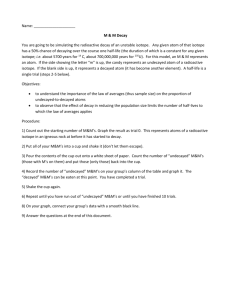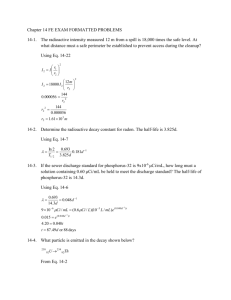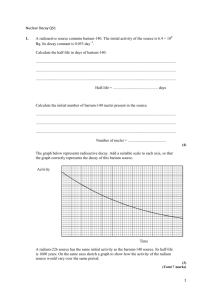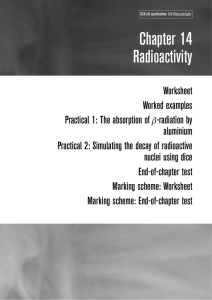Activity 4: Sweet Age Dating
advertisement
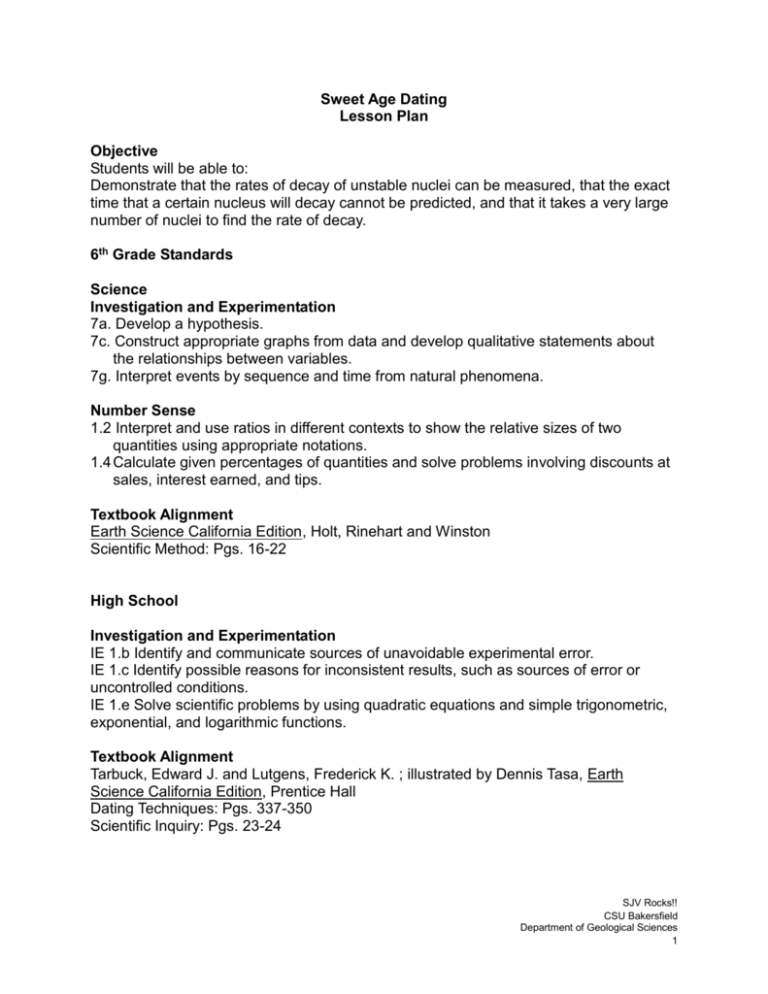
Sweet Age Dating Lesson Plan Objective Students will be able to: Demonstrate that the rates of decay of unstable nuclei can be measured, that the exact time that a certain nucleus will decay cannot be predicted, and that it takes a very large number of nuclei to find the rate of decay. 6th Grade Standards Science Investigation and Experimentation 7a. Develop a hypothesis. 7c. Construct appropriate graphs from data and develop qualitative statements about the relationships between variables. 7g. Interpret events by sequence and time from natural phenomena. Number Sense 1.2 Interpret and use ratios in different contexts to show the relative sizes of two quantities using appropriate notations. 1.4 Calculate given percentages of quantities and solve problems involving discounts at sales, interest earned, and tips. Textbook Alignment Earth Science California Edition, Holt, Rinehart and Winston Scientific Method: Pgs. 16-22 High School Investigation and Experimentation IE 1.b Identify and communicate sources of unavoidable experimental error. IE 1.c Identify possible reasons for inconsistent results, such as sources of error or uncontrolled conditions. IE 1.e Solve scientific problems by using quadratic equations and simple trigonometric, exponential, and logarithmic functions. Textbook Alignment Tarbuck, Edward J. and Lutgens, Frederick K. ; illustrated by Dennis Tasa, Earth Science California Edition, Prentice Hall Dating Techniques: Pgs. 337-350 Scientific Inquiry: Pgs. 23-24 SJV Rocks!! CSU Bakersfield Department of Geological Sciences 1 Materials For Each Team: 100 M&Ms® Calculators Gloves (optional) Plastic cup Student Handouts Chairs & large area For The Class: Class Data Table M&Ms® for the class (1 “large bag” is ~$7 and makes ~7 sets) Vocabulary Isotope - variants of atoms having differing numbers of neutrons Radioactive Decay – process by which an atomic nucleus of an unstable atom loses energy Relative Age Dating – the science determining the order of past events without determining their absolute age Absolute Age Dating – the age of the rock as measured by determine the radioactive decay Half-Life – Period of time it takes for a substance undergoing decay to decrease by half Guiding the Activity 1. Schedule This activity will take 40-45 minutes. After students have gathered the data, the M&Ms® may be discarded. 2. Introduce Main Content Concepts Make content inquires by asking questions, such as: How old are you relative to the other students in this school? How do you know that? How do scientists know how old the Earth is? SJV Rocks!! CSU Bakersfield Department of Geological Sciences 2 Below are ideas for introducing these topics: Discussion: Tell students: "Radioactive decay is a random process, like flipping a coin or other object that has its sides marked differently." Ask students: What is the chance of getting heads on any flip? What do we mean by random? Demonstration: Have students line up on one side of a large area and set up half as many chairs on the opposite side. Tell the students they are all parent isotopes and in order to stay parent isotopes they cannot decay. When you are ready tell the students to run to the other side and try to sit in a chair. If they make it to a chair they remain a parent isotope, if they do not make it to a chair they have decayed into daughter product. Continue until all students become daughter products. You can also tell the students their half-life rate and have them do the math at the end of the activity to calculate how many years it took for everyone to decay. Wrap Up Introduction: "We measure our rate of speed in a car in miles per hour. This method of measuring a rate won't work for radioactive decay. We know that radioactive substances disintegrate at a known rate, however. We call this rate the isotope's halflife. It is the length of time required for the disintegration of one-half of a given number of nuclei of a radioactive element. Let's begin with a small number. Suppose we have 100 nuclei of a radioactive isotope. After one half-life, half of the nuclei will have disintegrated, leaving 50 nuclei." Ask students: How many nuclei will be left after the second half-life? How many would you predict will be left after the third half-life? 3. Explain the Activity (From Student Handouts) Have students gather materials. Make sure to remind the students to stop at each “halflife” to report their numbers to the class. **Also the printed M’s may rub off if the students are handling them excessively.** Some ideas for questions: 1. What happens during each “half-life” episode? 2. What represents the parent isotope in this activity? 3. How does the daughter material form? 4. Discussion Have class discussion about the radioactive decay. What makes it radioactive decay? Why do scientists use radioactive decay as a way to calculate age? Have class discussion about absolute age dating vs. relative age dating. What makes absolute dating absolute? Why/when do scientists use relative dating? SJV Rocks!! CSU Bakersfield Department of Geological Sciences 3

